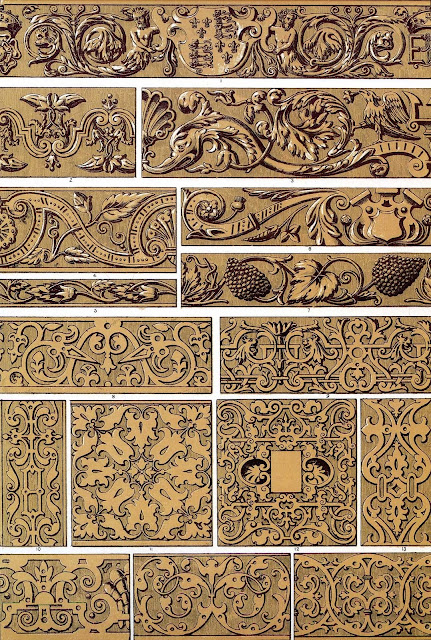Illustration: Elizabethan Ornament from Owen Jones The Grammar of Ornament, 1856.
The chapter dealing with Elizabethan Ornament in Owen Jones 1856 The Grammar of Ornament was actually written by John Burley Waring which is not unusual as a number of the chapters of the book were written by various friends, critics, and experts who Jones knew or was in contact with.
Waring himself saw the Elizabethan period of ornamentation as being part of a great continuation of an English style that had seen its formation in the gothic medieval period and was to continue to develop through the different periods of English history, finally reaching its very last flowering through the reigns of Henry VIII, Elizabeth I and James VI (I). It was under Henry's reign that a number of European elements, particularly those of the Italians and later the Dutch, came together with the native English decorative work, producing the style that we know as Tudor and Elizabethan.
Interestingly Waring saw the influence of the Italians and the Dutch as being associated with different reigns. He notes that Italian painters, decorators, and designers tended to populate Henry's court, while Elizabeth favoured the Dutch. Whether this was politically and religiously motivated is hard to say, though Waring himself makes it clear that he thought this was indeed the case. After all, it must be remembered that even though Henry broke with Rome he still died a Catholic. Elizabeth on the other hand, was raised and died as a Protestant.
Illustration: Elizabethan Ornament from Owen Jones The Grammar of Ornament, 1856.
In the latter part of Elizabeth's reign and in that of her Scottish successor James VI (I), whose reign Waring saw as a continuation of the general Elizabethan style, foreign influence tended to decrease and native English artists and craftsmen were seen to actively replace those of the Dutch at court. Whether this had something to do with an increase in confidence amongst indigenous workers, or political isolation, is unknown.
Waring concludes his chapter with the thought that easily fell in line with a number of mid-nineteenth century English critics of the decorative arts, including Owen Jones and later that of William Morris and the Arts & Crafts movement. The regret, as Waring termed it, was in the wholesale adoption of the classical European style that was so much a part of the Georgian era, in particular. Many in the Arts & Crafts world saw classicism as an ugly pseudo-style, a bland template that was meant to fit all elements of the decorative arts. A style that replaced the core value that was at the centre of English decoration, namely that of honesty to both decoration and materials. Classicism was seen as an affectation of the wealthy classes with no real roots or merit in the English landscape.
Illustration: Elizabethan Ornament from Owen Jones The Grammar of Ornament, 1856.
Even though Waring and others were aware of the influence of Europe on English decorative arts within the Elizabethan era, they also saw that the core element that was English had remained and that the influence of the Italians and the Dutch had enhanced, rather than obscured the domestic style of England. The later Arts & Crafts movement, along with William Morris who was a particularly vociferous critic of classicism, saw this period as the last real flowering of English decoration. Many felt that the foreign tones of classicism had cut off the native English decorative and ornamental style at the root, leaving no real domestic or indigenous element to continue. This gave the English Arts & Crafts movement its basic drive which in some respects particular and peculiar to the English segment of the international Arts & Crafts movement. The drive to reconnect with the Elizabethan decorative arts world, to continue and develop the long tradition that stretched back to that of the medieval period, was paramount to many. Consigning classicism to that of an anomaly within the English craft and decorative system, although a heartfelt wish, was never really going to succeed.
English style is now often seen as being Georgian, with the town house and the countryseat with their intrinsically classical decorative work being forefront in people's imagination. Elizabethan ornament in the Georgian period was very often torn out, thrown away, or worse still given a classical makeover in order for it to be approved and acceptable to the new order.
Further reading links:
The Grammar of Ornament: All 100 Color Plates from the Folio Edition of the Great Victorian Sourcebook of Historic Design (Dover Pictorial Archive Series)
Grammar of Ornament: A Monumental Work of Art
Art and Decoration in Elizabethan and Jacobean England: The Influence of Continental Prints, 1558-1625 (Paul Mellon Centre for Studies in Britis)
Elizabethan & Jacobean Style
Art and Decoration in Elizabethan and Jacobean England: The Influence of Continental Prints, 1558-1625.(Review): An article from: Renaissance Quarterly
English homes of the early renaissance;: Elizabethan and Jacobean houses and gardens
An Elizabethan Inheritance: The Hardwick Hall Textiles
Fragments and details of architecture, decoration, and furniture of the Elizabethan period: 92 plates selected from "Studies from old English mansions."
Elizabethan interiors
Materializing Space at an Early Modern Prodigy House: The Cecils at Theobalds, 1564-1607
Art and Decoration in Elizabethan and Jacobean England: The Influence



